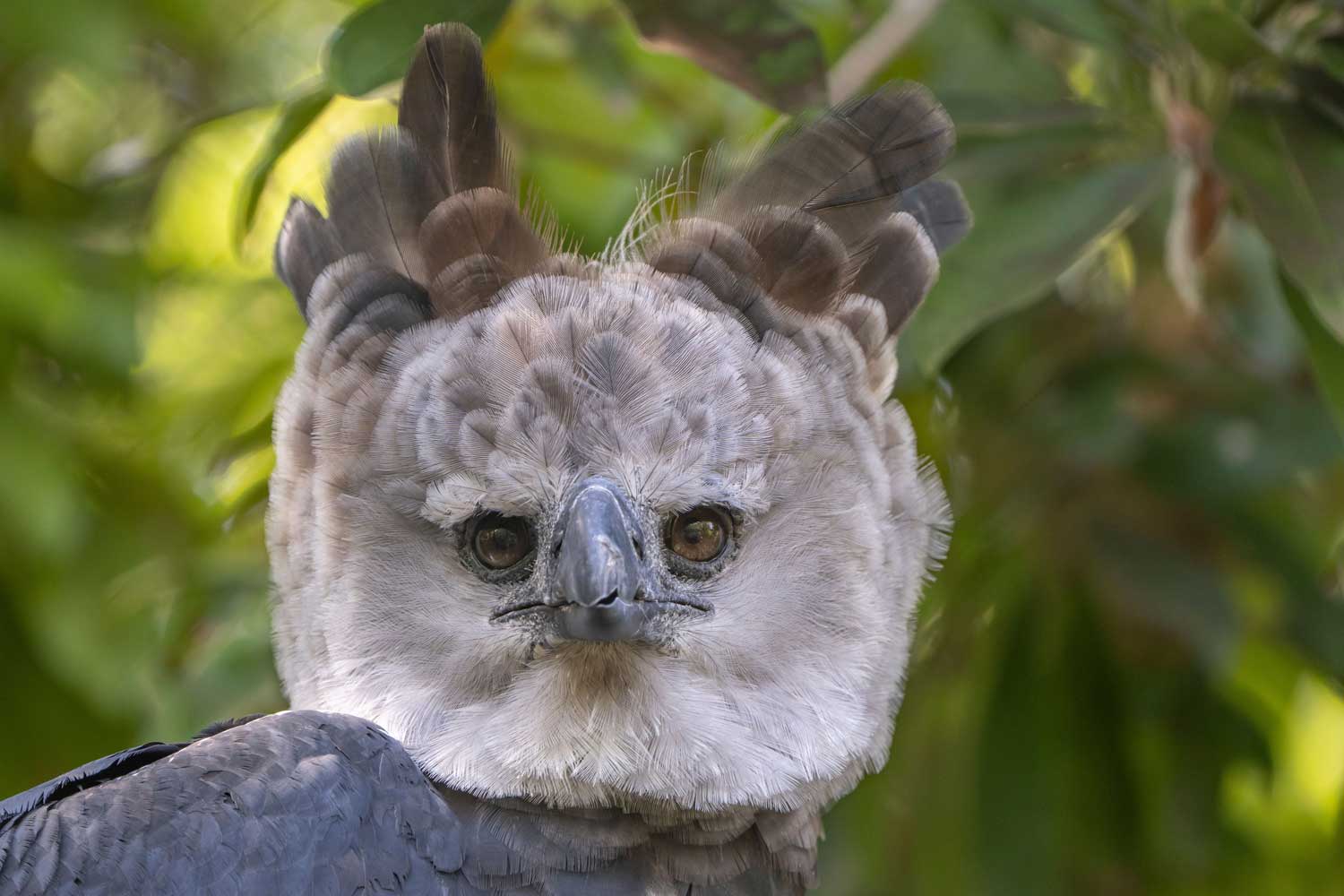Wild Relatives: The harpy eagle

Editor’s note: Our Wild Relatives story series will explore the connections between our local wildlife species and related animals from around the globe. By learning about these exotic species, we hope to foster appreciation for the remarkable creatures that live in our backyards and neighborhoods.
Bald eagles are an impressive-looking bird, immediately recognizable in their adult plumage thanks to their iconic white heads and hooked yellow beaks. Our national bird is one of about 60 eagle species worldwide, and some of the more far-flung eagle species are plenty impressive as well.
Take the harpy eagle. Just like the bald eagle, harpy eagles have a distinctive look, but it's not one you would confuse with the bald eagle. They are one of the largest eagle species in the world, mostly gray in color but with a white underside. They have a black band on their necks and a crest of feathers atop their heads. Harpy eagles are named for the harpies of Greek mythology, according to the San Diego Zoo. These part-bird, part-woman creatures were under Zeus's control, and he would send them out in storms.
Harpy eagles are primarily found in the rainforests of South America, where they can be found as far south as northern Argentina. They also live in smaller numbers in parts of Central America and southern Mexico, PBS reports.
Just like the bald eagle is our national bird, the harpy eagle is the national bird of Panama. That's not its only claim to fame. The Fawkes character in the Harry Potter series of books was inspired by the harpy eagle, and the bird is also the symbol of biodiversity in Ecuador and the emblem of the Colombian Air Force, according to the National Audubon Society.
Big birds
Harpy eagles are impressively sized. These birds can stand 36 inches to 40 inches tall, and their wingspan is an impressive 6 1/2 feet. As with most raptors, females are larger than males — almost twice as large. The female harpies weigh between 13 pounds and 20 pounds, while males weigh between 9 pounds and 11 pounds, according to PBS. Bald eagles have a similar wingspan to the harpy eagle, but they typically only weigh between 6 pounds and 12 pounds, with females being larger than males.
These large birds need a large range. A harpy eagle territory can be more than 10,000 acres in all, according to the American Bird Conservancy. In the rainforests where they live, they usually remain in the tree canopy. They seldom fly over the treetops, instead preferring to maneuver through the canopy because they don't have to expend as much energy.
Apex predators
We don't typically think of birds as being at the top of the food chain, but harpy eagles are apex predators in the rainforests where they live. They do not have any natural predators, according to the American Bird Conservancy.
Like our more familiar bald eagles, harpy eagles rely on excellent vision to hunt. They can see something as small as 1 inch from more than 200 yards away. They hunt while perched in the trees, and they swoop down to catch their prey with their impressive talons. Their black talons are 4 inches to 5 inches long — the same size as the claws on a grizzly bear, according to the National Audubon Society. Because of their long, strong talons, they are able lift prey that weighs as much as they do.
Harpy eagles mostly prey on animals that live in the same trees they do. Their diet is varied and includes monkeys, sloths, opossums, porcupines, snakes and iguanas. They may even snatch a young deer from the ground. Females typically prey on larger animals because they are much larger than the male birds. The eagles generally eat about 1 3/4 pounds of food each day, but they don't have to hunt every day, according to the Audubon Society. They will stash excess food in the trees and return later to eat it.
Lifelong partnerships
Monogamy isn't all that common in the animal kingdom in general, but it is fairly common among some kinds of birds. Most ducks, geese and swans are monogamous, and so are bald eagles and harpy eagles, among others. Harpy eagles partner for life and also share the workload over the first several months of their chicks' lives, although the females have a heavier parenting load than the males, according to the San Diego Zoo.
Breeding pairs construct their nests high up in the trees, as high as 165 feet above the ground, the Audubon Society reports. Big birds need big nests, and harpy eagle nests do not disappoint. Their nests, which they construct from sticks, can be the size of a double bed. The pair brings fresh twigs to the nest to help keep it free of insects and parasites.
Harpy eagles only mate every two or three years. The female will lay one or two eggs, but typically only one chick survives because once one egg hatches the chick gets all the parents' attention and the second egg is not properly incubated, the San Diego Zoo reports. The chicks are fed by their parents for about 10 months after hatching, and they begin the process of fledging when they are about 5 months or 6 months old.
Mounting threats
Harpy eagles may not have many natural predators, but they do face many threats. The International Union for Conservation of Nature's Red List of Threatened Species classifies the harpy eagle as vulnerable, and their population is declining. Today, harpy eagles are rare across much of their native range, the San Diego Zoo reports.
Loss of habitat is one of the primary threats these impressive birds face. Each established pair of harpy eagles requires a large undisturbed area of forest for hunting and nesting, but the tropical rainforests where they live have been decimated by logging activities, according to the zoo. Additional threats include poaching and destruction of nesting sites, and more recently hunters have begun killing the eagles for sport.
Because harpies only breed every two or three years and usually only raise one chick from each brood, it can be difficult for their population to recover once it begins to decline. The Peregrine Fund established a breeding program for the birds in 1989. Through the program, nearly 50 adult harpy eagles were released in the wild in Belize and Panama.
